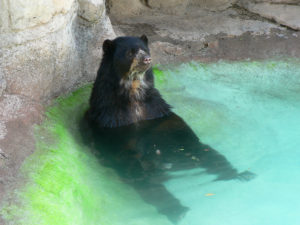The Zoo Heats Up
 Temperatures are rising in Tucson and the Zoo, jam-packed with visitors all spring, is starting to quiet down in the afternoons. But what about the animals? If we’re hot, aren’t they hot? How does the Zoo make sure its animal residents stay healthy and comfortable in warmer weather?
Temperatures are rising in Tucson and the Zoo, jam-packed with visitors all spring, is starting to quiet down in the afternoons. But what about the animals? If we’re hot, aren’t they hot? How does the Zoo make sure its animal residents stay healthy and comfortable in warmer weather?
First of all, many of the animals at the Zoo are naturally adapted to warm temperatures. After all, it gets hot in the wild too! African elephants provide a great example of how some animals cool themselves naturally—the elephants flap their big ears to cool blood as it flows through those vessels, and the blood then cools the rest of their bodies as it flows back to their hearts.
The Zoo provides water and shade for the animals too. If you visit the Zoo in the summer you might see Worf, the male Andean bear, sitting in his pool, or the tigers resting near the waterfall in their exhibit. The elephants have a shade structure, but it’s interesting how seldom they choose to stand underneath it—they prefer rolling in one of their mud pits, or going for a swim in their 90,000 gallon pool to cool off.
On the hottest days, sensitive animals are given access to their night houses, many of which are equipped with swamp coolers or misters. Zoo guests may occasionally be disappointed at not seeing these animals on exhibit but ultimately, the animals’ health is the Zoo’s biggest priority.
Stay cool out there!
